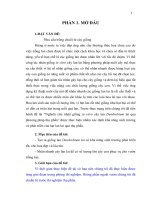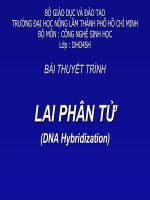Công nghệ sinh học
Bạn đang xem bản rút gọn của tài liệu. Xem và tải ngay bản đầy đủ của tài liệu tại đây (132.05 KB, 6 trang )
Endosymbiosis and The Origin of
Eukaryotes
The endosymbiosis theory postulates that
• The mitochondria of eukaryotes evolved from aerobic bacteria (probably related to
the rickettsias) living within their host cell.
• The chloroplasts of eukaryotes evolved from endosymbiotic cyanobacteria
(autotrophic prokaryotes).
• Eukaryotic cilia and flagella may have arisen from endosymbiotic spirochetes. The
basal bodies from which eukaryotic cilia and flagella develop would have been able
to create the mitotic spindle and thus made mitosis possible.
The evidence for mitochondria and chloroplasts
• Both mitochondria and chloroplasts can arise only from preexisting mitochondria
and chloroplasts. They cannot be formed in a cell that lacks them because nuclear
genes encode only some of the proteins of which they are made.
• Both mitochondria and chloroplasts have their own genome and it resembles that of
prokaryotes not that of the nuclear genome.
o Both genomes consist of a single circular molecule of DNA.
o There are no histones associated with the DNA.
• Both mitochondria and chloroplasts have their own protein-synthesizing machinery,
and it more closely resembles that of prokaryotes than that found in the cytoplasm
of eukaryotes.
o The first amino acid of their transcripts is always fMet as it is in bacteria
(not methionine [Met] that is the first amino acid in eukaryotic proteins).
o A number of antibiotics (e.g., streptomycin) that act by blocking protein
synthesis in bacteria also block protein synthesis within mitochondria and
chloroplasts. They do not interfere with protein synthesis in the cytoplasm
of the eukaryotes.
o Conversely, inhibitors (e.g., diphtheria toxin) of protein synthesis by
eukaryotic ribosomes do not — sensibly enough — have any effect on
bacterial protein synthesis nor on protein synthesis within mitochondria and
chloroplasts.
Index to this page
• The Mitochondrial Genome
• The Chloroplast Genome
• Secondary Endosymbiosis
o The Nucleomorph
o The Apicoplast
o Can Secondary Symbiosis Still Occur?
o The antibiotic
rifampicin, which
inhibits the RNA
polymerase of
bacteria, also inhibits
the RNA polymerase
within mitochondria. It
has no such effect on
the RNA polymerase
within the eukaryotic
nucleus.
The Mitochondrial
Genome
The genome of human mitochondria contains 16,569 base pairs of DNA organized in a
closed circle. These encode:
• 2 ribosomal RNA (rRNA) molecules
• 22 transfer RNA (tRNA) molecules (shown in the figure as yellow bars; two of
them labeled)
• 13 polypeptides
The 13 polypeptides participate in building several protein complexes embedded in the
inner mitochondrial membrane.
• 7 subunits that make up the mitochondrial NADH dehydrogenase
• 3 subunits of cytochrome c oxidase
• 2 subunits of ATP synthase
• cytochrome b
All these gene products are used within the mitochondrion, but the mitochondrion also
needs proteins encoded by nuclear genes. These proteins (e.g., cytochrome c and the RNA
and DNA polymerases used within the mitochondrion) are synthesized in the cytosol and
then imported into the mitochondrion.
The Chloroplast Genome
The genome of the chloroplasts found in Marchantia polymorpha (a liverwort, one of the
Bryophyta) contains 121,024 base pairs in a closed circle. These make up some 128 genes
which include:
• duplicate genes encoding each of the four subunits (23S, 16S, 4.5S, and 5S) of the
ribosomal RNA (rRNA) used by the chloroplast
• 37 genes encoding all the transfer RNA (tRNA) molecules used for translation
within the chloroplast. Some of these are represented in the figure by black bars (a
few of which are labeled).
• 4 genes encoding some of the subunits of the RNA polymerase used for
transcription within the chloroplast (3 of them shown in blue)
• a gene encoding the large subunit of the enzyme RUBISCO (ribulose bisphosphate
carboxylase oxygenase)
• 9 genes for components of photosystems I and II
• 6 genes encoding parts of the chloroplast ATP synthase
• genes for 19 of the ~60 proteins used to construct the chloroplast ribosome
All these gene products are used within the chloroplast, but all the chloroplast structures
also depend on proteins
• encoded by nuclear genes
• translated in the cytosol, and
• imported into the chloroplast.
RUBISCO, for example, the enzyme that adds CO
2
to ribulose bisphosphate to start the
Calvin cycle, consists of multiple copies of two subunits:
• a large one encoded in the chloroplast genome and synthesized within the
chloroplast, and
• a small subunit encoded in the nuclear genome and synthesized by ribosomes in the
cytosol. The small subunit must then be imported into the chloroplast.
The arrangement of genes shown in the figure is found not only in the Bryophytes (mosses
and liverworts) but also in the lycopsids (e.g., Lycopodium and Selaginella). In all other
plants, however, the portion of DNA bracketed by the red arrows on the left is inverted.
The same genes are present but in inverted order. The figure is based on the work of
Ohyama, K., et al., Nature, 322:572, 7 Aug 1986; and Linda A. Raubeson and R. K.
Jansen, Science, 255:1697, 27 March 1992.
The evolution of eukaryotic chloroplasts by the endosymbiosis of cyanobacteria seems to
have occurred on three different occasions producing as separate events:
• the green algae and plants as described above
• red algae
• glaucophytes; a small group of unicellular algae.
Secondary Endosymbiosis: Eukaryotes Engulfing
Eukaryotes
The Nucleomorph
Once both heterotrophic and photosynthetic eukaryotes had evolved, the former repeatedly
engulfed the latter to exploit their autotrophic way of life. Many animals living today
engulf algae for this purpose [Link to
examples]. Usually the partners in these
mutualistic relationships can be grown
separately.
However, a growing body of evidence
indicates that the chloroplasts of some
algae have not been derived by engulfing
cyanobacteria (prokaryotes) in a primary
endosymbiosis like those discussed
above, but by engulfing photosynthetic
eukaryotes. This is called secondary
endosymbiosis. It occurred so long ago
that these endosymbionts cannot be
cultured away from their host.
In two groups, the eukaryotic nature of the endosymbiont can be seen by its retention of a
vestige of a nucleus (called its nucleomorph).
• A group of unicellular, motile algae called cryptomonads appear to be the
evolutionary outcome of a nonphotosynthetic eukaryotic flagellate (i.e., a
protozoan) engulfing a red alga by endocytosis.
• Another tiny group of unicellular algae, called chlorarachniophytes, appear to be
the outcome of a flagellated protozoan having engulfed a green alga.
The result in both cases: a motile, autotrophic cell containing:
• its own nucleus
• its own mitochondria
• its own endoplasmic reticulum, which contains the endosymbiont with
o its own plasma membrane
o its own cytoplasm, the periplastid space
o its own ribosomes
o its own chloroplast, and
o its nucleomorph - only a vestige of its original nucleus, but still
surrounded by a nuclear envelope perforated with nuclear pore
complexes and
containing a tiny but still-functioning genome.
The Four Genomes of Guillardia theta
The cryptomonad Guillardia theta contains four different genomes:
• its own nuclear genome; by far the largest with ~350x10
9
base pairs (bp) of DNA;
• the genome of its mitochondria (48,000 bp);
• the genome of the chloroplast in its endosymbiont (121,000 bp);
• the genome of the nucleomorph (551,264 bp).
Susan Douglas and her colleagues reported (in the 26 April 2001 issue of Nature) the
completely-sequenced genome of the nucleomorph.
It contains 3 small chromosomes with
• 47 genes for nonmessenger RNAs (rRNA, tRNA, snRNA)
• 464 genes for messenger RNA; that is, encoding proteins such as
o 65 proteins for its own ribosomes
o 30 for its chloroplast (a small fraction of the hundreds needed)
o a variety of proteins needed within the nucleomorph, including
DNA licensing factors
histones
proteins needed for DNA replication (but no genes for DNA
polymerases, which must be translated by and imported from the
host ribosomes)
The genes are crowded closely on the three chromosomes. In fact, 44 of them overlap each
other. Only 17 genes contain introns, and these are very small.
Genome Interactions in Guillardia theta
Millions of years of evolution have resulted in a complex but precisely-orchestrated array
of interactions between the 4 genomes. For example:
• The chloroplast needs proteins synthesized by 3 different genomes: its own, the
nucleomorph's, and the host's.
• The nucleomorph genome has given up all (but one) of its genes encoding enzymes
for general metabolic functions; the endosymbiont now depends on those encoded
by the host nucleus.
• The nucleomorph itself also depends on genes (e.g., for DNA polymerases) residing
in the host nucleus.
The Apicoplast
The apicoplast (short for "apicomplexan plastid") is a solitary organelle found in the
apicomplexan protists: "sporozoans" like Plasmodium falciparum (and the other agents of
malaria) and Toxoplasma gondii.
Features:
• Essential - the organisms cannot survive without it;
• Encased by 4 membranes;
• Contains its own genome, a circular molecule of DNA (35,000 base pairs) which
encodes
o ~ 30 proteins
o a full set of tRNAs plus some other RNAs
• Only a few functions have been discovered, but these include
o anabolic metabolism such as the synthesis of fatty acids;
o repair , replication, transcription, and translation of its genes.









